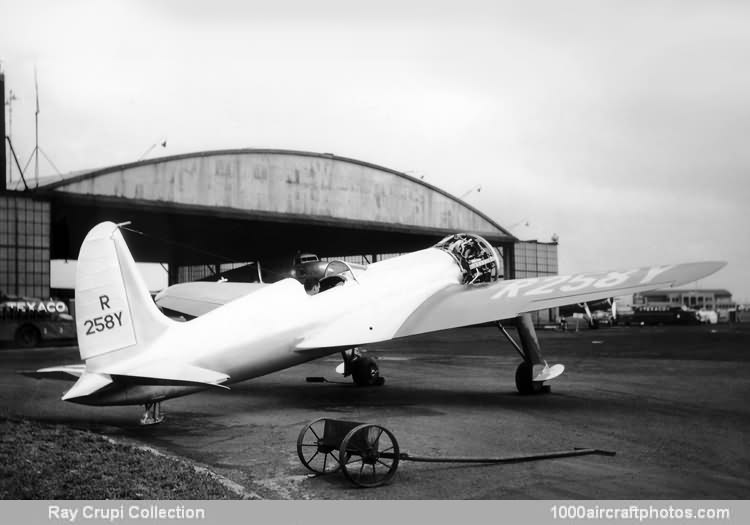11/15/2014. Remarks by Johan Visschedijk: "The Hughes H-1 racer was developed to be the fastest landplane in the world, It was designed by Howard Hughes and Richard Palmer and built by Glenn Odekirk. On September 13, 1935, Hughes achieved the design goal by flying the H-1 to a new world speed record of 352.322 mph (567.007 kmh). The record was set over a specially instrumented course near Santa Ana, California.
Since Hughes did not require a sponsor for the aircraft, the H-1 had no markings except the license number NR258Y (also seen as R258Y, later NX258Y) in chrome yellow against the dark blue background of the wings, and in black against the doped aluminum rudder. The fuselage was left in its natural polished aluminum finish. The H-1 was powered by a Pratt and Whitney Twin Wasp Junior radial piston engine, which was rated at 700 hp at 8,500 ft (2,591 m) but which could deliver 1,000 horsepower for high-speed flight. A wind tunnel model of the aircraft was exhaustively tested in the 200-mph (322 kmh) wind tunnel at the California Institute of Technology's Guggenheim Aeronautical Laboratory. Actual performance figures for the aircraft closely matched the predicted design performance.
The H-1 had two sets of wings. The short set Hughes used to break the landplane speed record were of a low aspect ratio and had a span of 25 ft 0 in (7.62 m). The long set with a span of 31 ft 9 in (9.68 m) were used when Howard Hughes broke the transcontinental speed record in the H-1 on January 19, 1937. Hughes departed Los Angeles before dawn and arrived at Newark Airport, outside New York City, 7 hours, 28 minutes, and 25 seconds later. His average speed over the 2,490-mile (4,007 km) course was 332 mph (518 kmh), and this non-stop flight was truly an outstanding accomplishment.
The Hughes H-1 was designed for record-setting purposes, but it also had an impact on the design of high-performance aircraft for years to come. Some of the outstanding design features of the H-1 were: a close fitting bell-shaped engine cowling to reduce airframe drag and improve engine cooling; gently curving wing fillets between the wing and the fuselage to help stabilize the airflow, reduce drag, and prevent potentially dangerous eddying and tail buffeting; retractable landing gear to reduce drag and increase speed and range (typical of everything or the H-1, the landing gear was so perfectly fitted that the gear fairings and doors are difficult to see without looking closely); all rivets and joints flush with the aircraft's skin and flathead and counter-sunk screws on the plywood wings; ailerons designed to droop 15° when the flaps were fully extended to improve lift along the full length of the wing during landing and take off; the pilot sitting in a smoothly faired and totally enclosed cockpit, which had an adjustable canopy windscreen to permit easy entry and exit from the aircraft.
The Hughes H-1 racer was a major milestone aircraft on the road to such radial engine-powered WW II fighters as the American Grumman F6F Hellcat and Republic P-47 Thunderbolt, the Japanese Mitsubishi Type 0 ("Zero"), and the German Focke-Wulf Fw 190. It demonstrated that properly designed radial-engined aircraft could compete with the lower-drag in-line designs despite having larger frontal areas because of their radial engine installations.
The H-1 was kept in the Hughes factory at Culver City, California, until it was donated to the Smithsonian Institution in 1975. It is now exhibited in the Golden Age of Flight gallery of the National Air and Space Museum. A virtually exact flying replica was produced in 2002."
